
Get in, get out. Go somewhere to get nowhere. Travel through the space that exists between you and places you’ve never been. Open the door to your cobweb-cluttered mind, welcoming a fresh breeze to disturb the mess within. Try to leave behind the nonsense you’ve been burdened with by expectations that are impossible to satisfy. Then, sit down to a meal of crispy hot knowledge where the shadows of ignorance will come under threat. When we embark on passing into new experiences where nothing is defined, we will likely find ourselves dining alone on the bitter diet of alienation, as who in their right mind would subject themself to introspection and uncertainty after finding cocksurety in the arrogance of all-knowing stupidity?
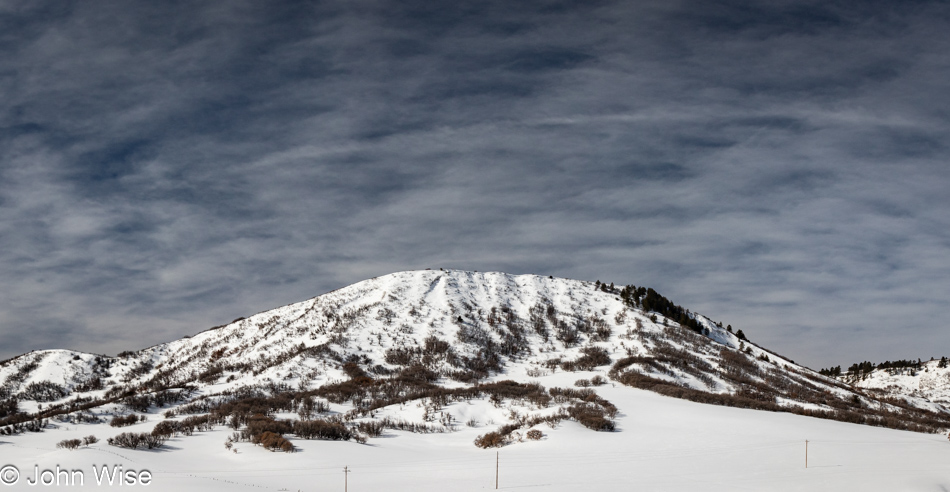
We’ve been traveling in a counter-clockwise direction to unwind the spring that is designed to take us forward into expectations. Time is reversing to deny us our orientation with certainty. We revert to a previous mind, the one we carried as children when everything was still new. We are failing to respect convention and custom as we choose to find a new path; I am experiencing familiarity while Carlos travels into a multi-sensorial universe inconceivable just 72 hours earlier. We end up writing and rewriting our internal mappings that drive an operating system running on an auto-pilot setting that helps direct what our future narratives will borrow in order to take form. All the while, the inclination is to believe we are simply following a road that will bring us to something known.
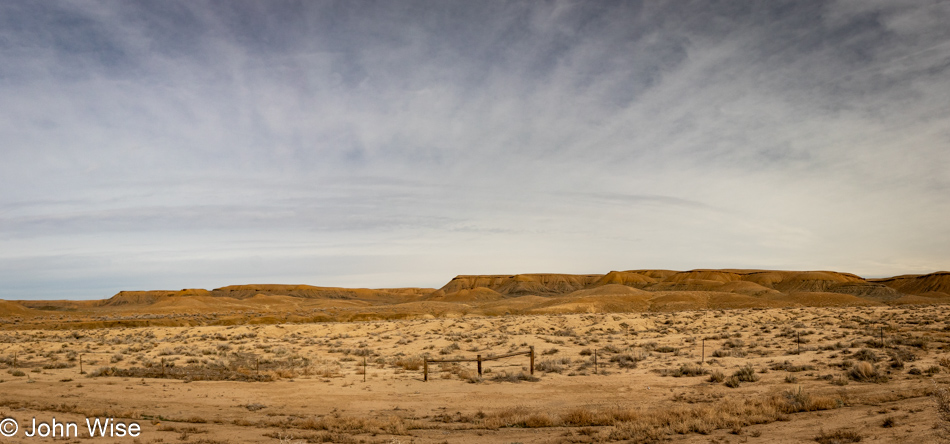
How could anyone have known the day would start in an authentic French bakery in a mountain town, followed by a slow drive through a snowy environment before being dumped back out in the arid desert? While you might think that, as the planner of this adventure, I would be in possession of that knowledge, the reality is that I considered roads to places separated by reasonable driving distances and then let the pieces fall into place. At any juncture along the way, we may have needed to deviate from the route due to weather, an accident, or even incompatibility between two forces of life that, in an instant found themselves living 24/7 side-by-side.

Time to put Colorado behind us for a quick dash to Mexican Hat, Utah, where I hope we can check in early to our motel, dump our bags, and race over to the Navajo Welcome Center at Monument Valley. We have an appointment for 12:30 to meet up with Cody for a guided tour out on the Mystery Valley Trail. This is the reason there are but a few photos representing the first half of the day, though we passed dozens of beautiful snowy landscapes I would have loved to photograph. Believe it or not, this trip has nothing to do with my photography or what I might be looking for; it’s really about what Carlos might discover along the way. This was also a pivotal moment for him. Yesterday, before confirming today’s adventure, I asked him if he was able or willing to pony up his share of the cost for the hike I had in mind. It’s not every day we are confronted with a per-person cost of $180 to be brought into an environment where a good amount of time would be spent walking around through a desert landscape. Strangely enough, he opted to see what the pricey journey might entail.
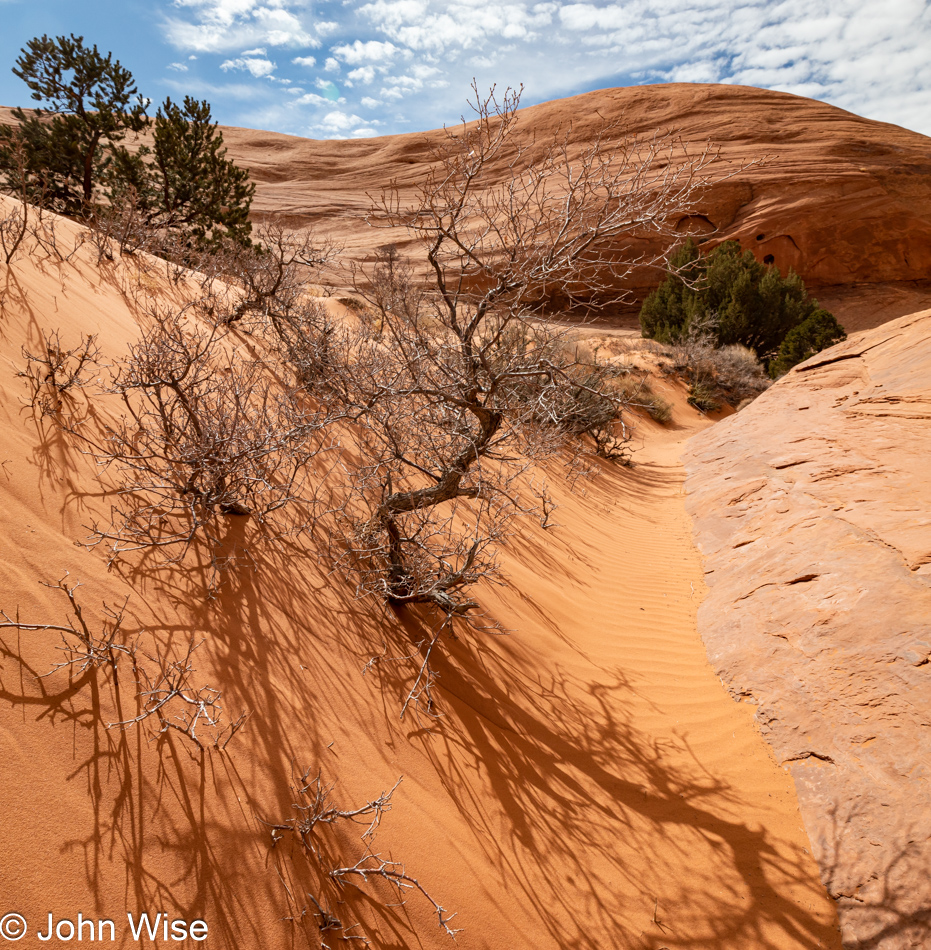
We are only slightly southwest of Monument Valley but simultaneously a world away in a place rather isolated. Tire tracks are common, although the sight of the vehicles that left have them will be hard to come by, so we take in the shadows as they stretch over the landscape and will have to imagine the footprints of those Iceage Paleo-Indian hunters that are said to have roamed here starting some 14,000 years before Europeans arrived. As for the shadows, they arrived with the return of the rising sun.
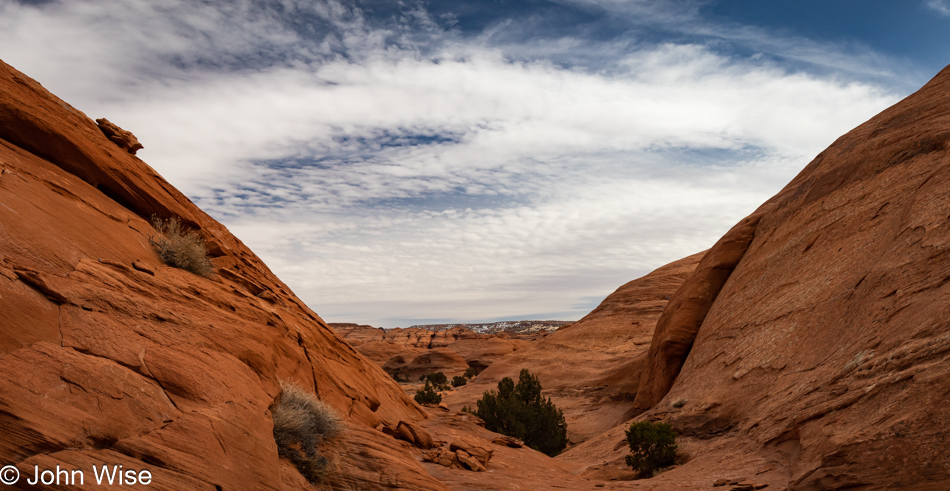
The Grand Canyon sees about 12,400 visitors a day, and the Great Smoky Mountains National Park sees about 38,600 visitors per day. In this photo we are seeing absolutely nobody, and, should it stay this way, there will be no sad visitors to Mystery Valley today.

Spoke too soon; here we see John Wayne because John Wayne is always near.

In the 192 million years of Monument Valley’s history and with two people standing at this particular point on earth, this is the first time ever that photos were taken of one another. This will never be duplicated due to the impossibility of seeing the exact type and quality of lighting and sky that was rapidly changing here today or even knowing just where it was we were standing.
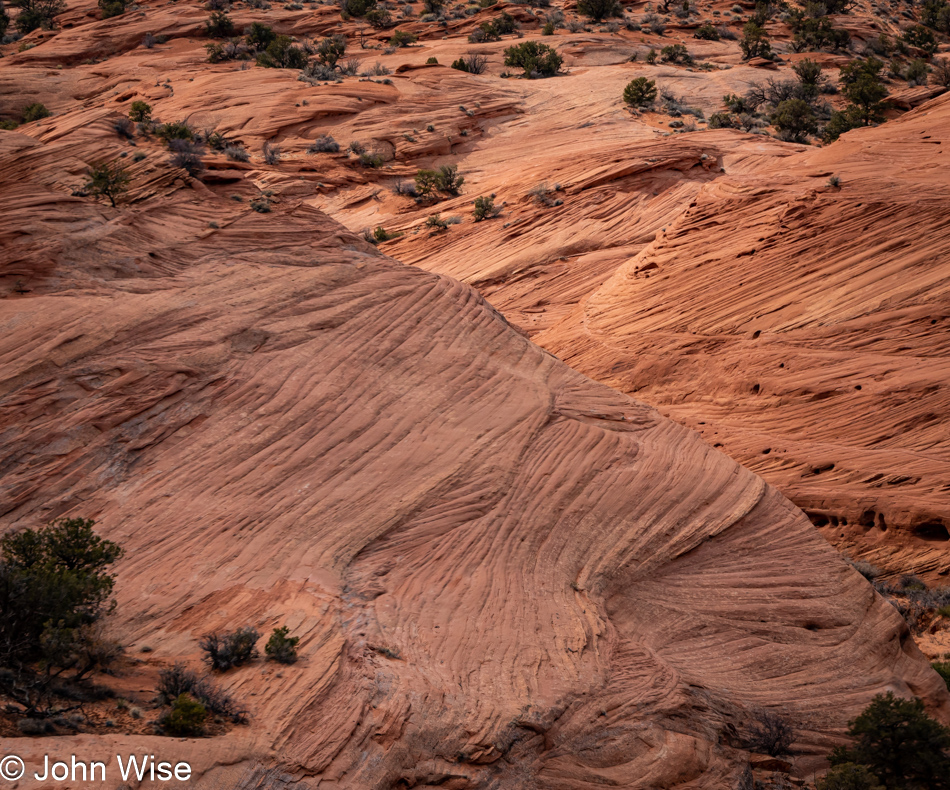
On any given day, one might be looking at this scene and, on the very next day, believe they are looking at the same thing, but superposition says this isn’t exactly true. From one day to the next, something changed: a plant grew, grains of sand were blown about, a lizard shifted a thing unseen, and so while the unchanged part is seen, so are the changes though our ability to recall find details might not readily pick up on those differences. You, too, are in a superposition of yourself because you may not perceive how you changed from one day to the next; in the mirror, you will be gazing upon the two versions of yourself, the one that existed yesterday and this new one that gathered something different and has likely changed your trajectory and perception.
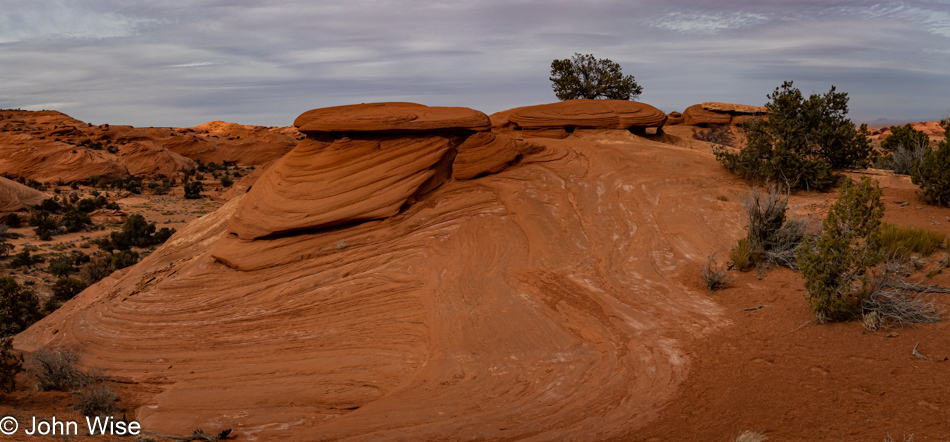
When we are out in unfamiliar places, we are processing a world of differences as we read and learn about the environment. We are, in effect, taking steroids and building muscles, but while our brain becomes swole with the strength of this kind of exercise, we cannot see the bulging pecs of a mind taking on greater definition, and so we discount the value of these experiences.
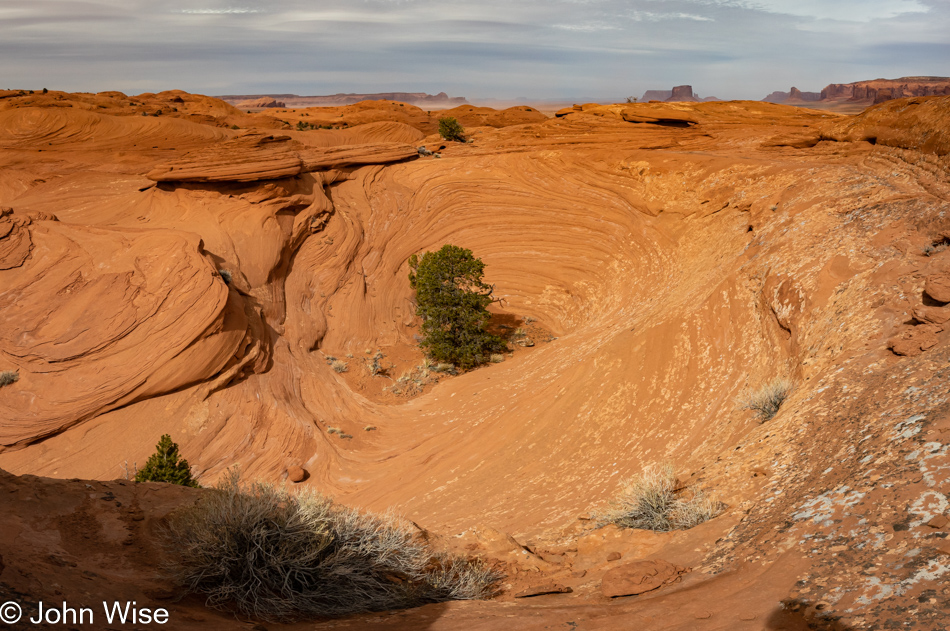
Play a videogame, and over time, a person will develop skills that allow the battles and puzzle solving to become easier, but what does one improve upon in their mindscape when considering a tree growing in a bowl of swirly sandstone? What skills are honed or strengths achieved when observing the world around us as an aesthetic body that might be embued with ideas of beauty?

Prior to the arrival of the Navajo, the Ancestral Puebloans (Anasazi) roamed these lands. I grew up with the ugly manufactured idea that arose out of the Rousseauian concept of the Noble Savage, where white ethnographers romanticized the idea that the Anasazi simply disappeared as a kind of phenomenon. Creating a mystery is more exciting for the imagination than dealing with truths that point to marginalized people forced onto reservations and stripped of their ways of life. In many cases, their children were stolen to ensure they took on the attributes of the dominant culture, though they would never actually become part of that. With a fantasy created, the white inhabitants could reasonably claim that they weren’t corraling authentic people with real history. Those natives were now extinct, and the ones being forced into capitulation were savages intent on destroying opportunities for whites while also threatening our womenfolk. The people who lived on these lands a millennia ago were Ancestral Puebloans who continue to live spread out across the Four Corners Region of the Southwest.

Being out here with Cody leading us through these red rocks is amazing in its own right, but I would love the opportunity to camp here for a number of days, leaving the truck behind while we simply walk about, sit for a while, watch and listen to the coming and going of night and day. The reality of our time here is one of a financial equation, a man gets paid so he can continue to exist on land he may have inherited, but the dictates of the modern economy have conditioned him to understand that money equals food and freedom, and if one only has enough for food, his freedom is effectively damned and time made precious and rare.
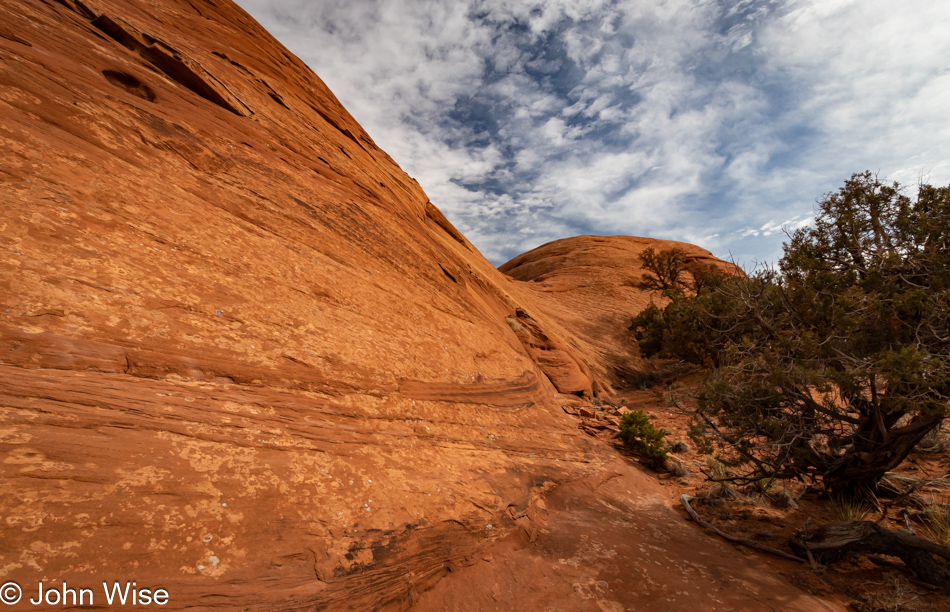
The dominant culture of the United States might claim that Americans exist in an egalitarian society, but that’s nothing more than bald-faced lies, similar to those told to people surviving in the straights of poverty by a bourgeoisie protecting the wealth they are afraid could slip away. What happens when not only your inner wealth slips away, but your cultural wealth is torn from the group, and you are left with mythologies that don’t pay for a sack of flour and a hunk of meat? You despair and foment hate with a dose of resentment, or at least I would. I wonder how Americans would feel about their homes being taken in a big roundup while simultaneously forced to acknowledge that Jesus no longer exists and that they’ll be prosecuted and reeducated should they continue to hold on to such primitivism?

The ironic thing is that the imagination and intellect of the lower socio-economic 2/3rds of the U.S. population have essentially had just that happen to them as they have been stripped of an education that would serve them well in an age of rapidly ascending technology they barely comprehend. Their overlords are creating a complexity using a technological language that relegates this majority to being that of savages and not particularly romanticizable savages. It is as though the modern American masses are becoming an indecipherable bit of rock art that reflects an ancient society lost in time. Humanity is being lost.

People from between 700 and 2,000 years ago made this pottery, and as it lost its utility, it was left here. When the people of today die, they will leave behind nothing they created with their own hands; they will leave trash, while the memories they gathered from their participation in a media-driven society will leave no signs. Fortunately, these beautiful pieces of pottery that act as reminders of those who came before have so far survived the intrusion of outsiders who sadly, would pay upwards of $1000 for a piece of jewelry made with some of these fragments. We would steal the historical reflections of these ancestors in order to feed our ego and guts, caring not one bit about whose heritage we erase.

This is a reminder to the future generations that would walk in the Ancestral Puebloan’s footsteps that others learned how to survive here. It is an important history lesson and a challenge for those who follow to learn how to live with less.

I can’t really say I’ve seen a lot of pottery shards in my lifetime, but I’ve likely seen more than most. This, though, is the first time I’ve seen a piece with a small hole carved into it that I’m going to make the semi-educated guess was there in order to make carrying the vessel a bit easier by using a bit of leather or maybe a twined rope made of yucca. Should you ever find your way out in Mystery Valley, maybe you’ll spot this piece, too, as it’s still lying right where we found it.
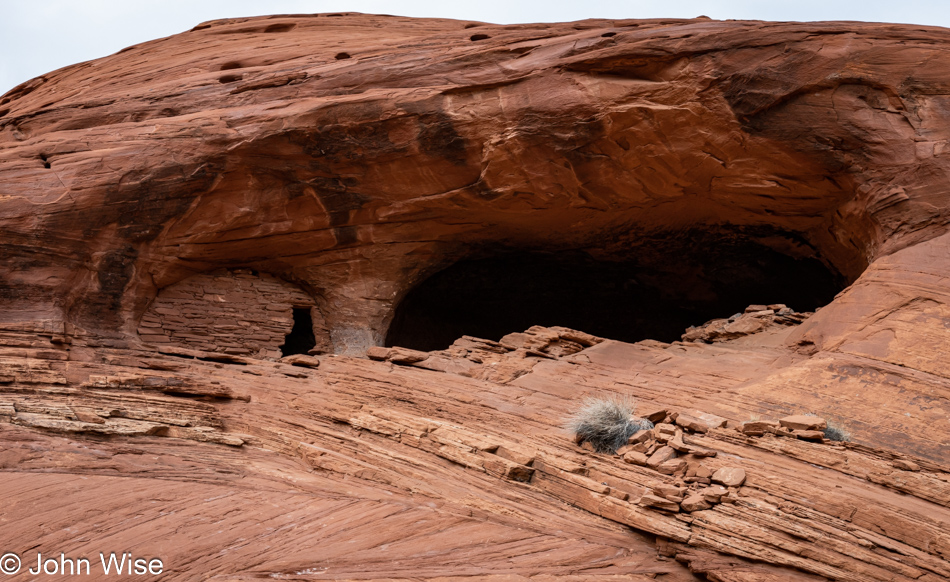
This was home to at least a small handful of Ancestral Puebloans many hundreds of years ago. It was certainly not a dwelling the Navajo would have lived in as their pre-Western contact homes were hogans and sweat houses (sweat lodges) known in Navajo as k’eet’soo’ii.
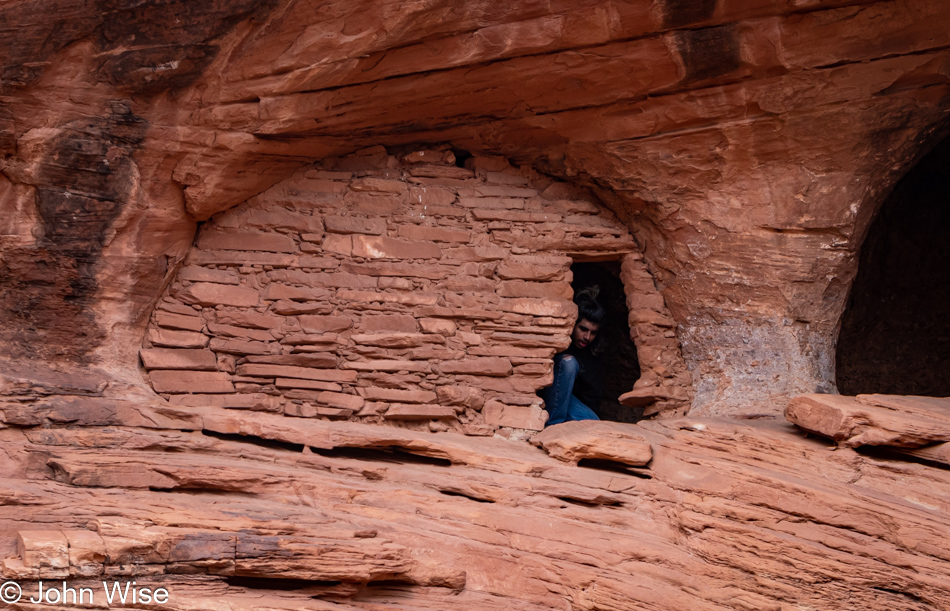
While I was scoping photography opportunities and contemplating silence, Carlos responded to the opportunity of climbing up the cliff face and carefully crawled through the narrow entryway into the long-abandoned cliff dwelling. While I would love to experience the view from above and within, my fear of heights combined with the steep exposure stymied me yet again; well, we can’t do everything, can we?
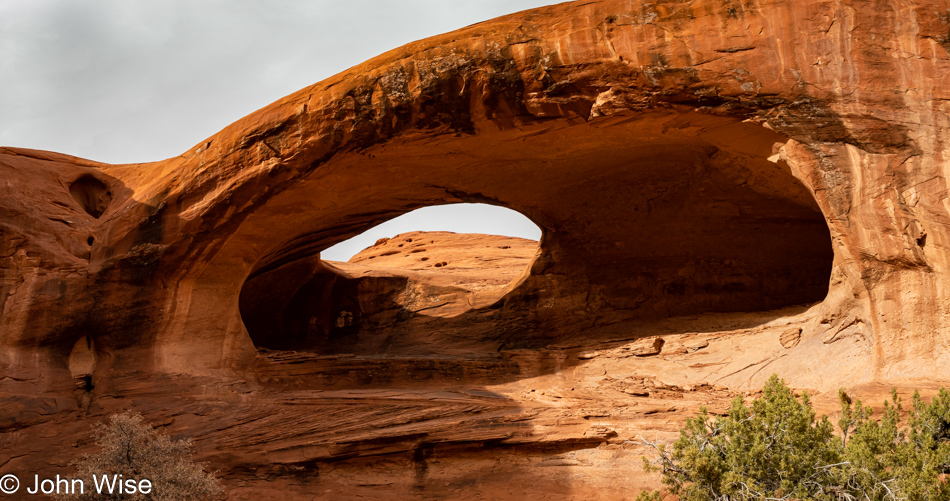
Somewhere along the trail, Carlos points out how this is possibly the first time he’s been somewhere so absent of others. This wasn’t a lament; it felt enthusiastic that he should be having such an experience and seeing the world with the eyes of real surprise that might redefine the way he relates to the idea of what a desert is.
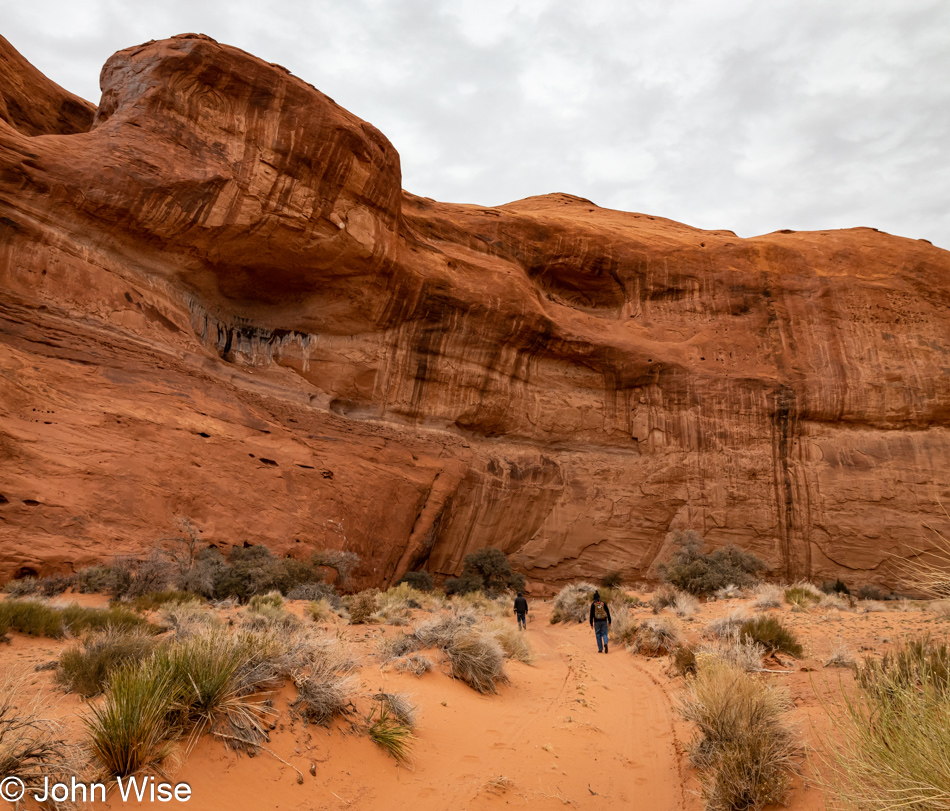
Cherish these moments, Carlos, as over the past 25 years, Caroline and I have found these isolated situations are becoming rarer. The luxury of being in the quiet, open spaces where beauty can be found is disappearing, in large part due to social media and the #doitforthegram crowd. Once Instagram and its influencers take away some of the appeals of pristine places such as what’s happening to Iceland, Pedra do Telégrafo, the Cliffs of Moher, Macchu Picchu, and the Hooker Valley Track, aspiring influencers looking for fame and fortune must discover their own places that will inspire others to be cool like them.
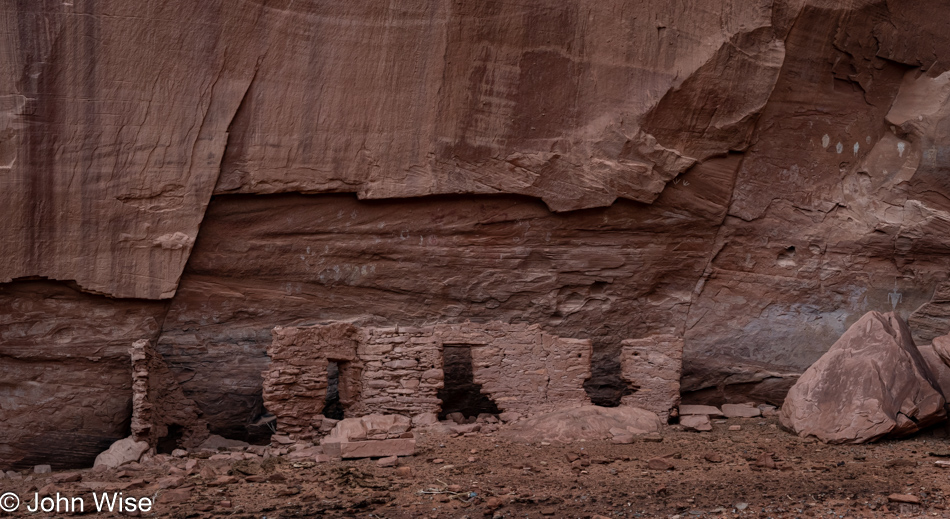
To stand here in silence and solitude with no one else present offers the visitor a moment to capture a sense of place taken out of a time prior to the advent of the camera and crowds. We are at The House of Many Hands.

A picture is worth a thousand words, except when it’s not. There are four human-looking pictographs on this panel along with more than a few handprints, but I have no facility to decipher them but maybe I don’t really need to. Is it only my desire to solve the mystery that I want to imbue the figures with special meaning, as I think they may contain secrets that were meaningful to the Ancestral Puebloans? What if they were simply art for art’s sake?
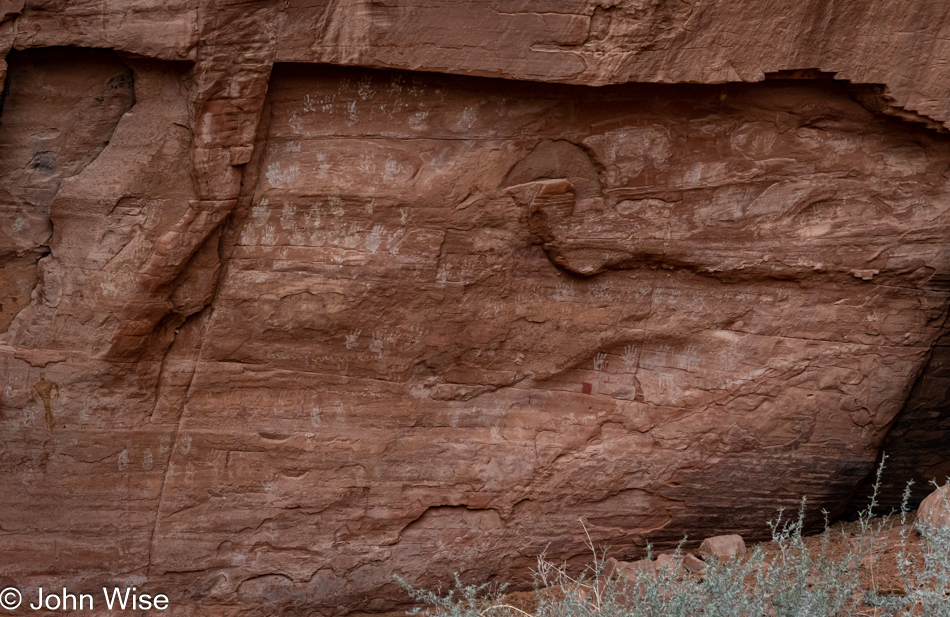
Hands that touch, hands that hold, hands that love. Hands that write, hands that draw, hands that paint. Hands that steer, hands that give, hands that take.
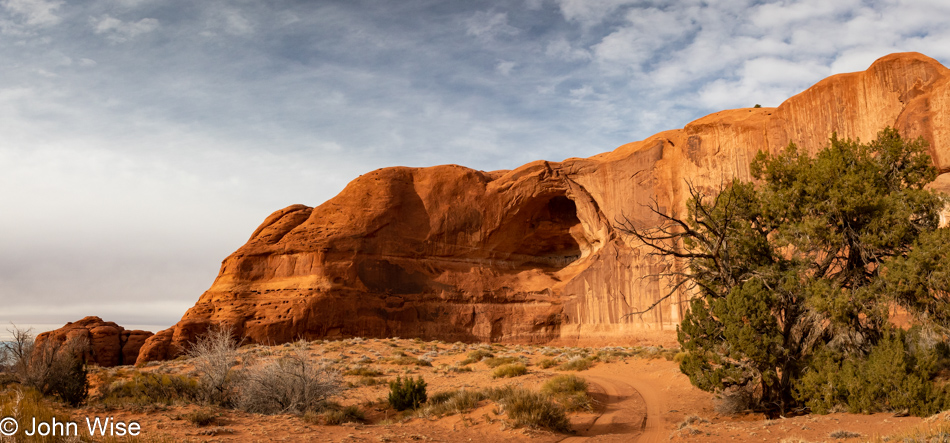
Eyes that take, eyes that translate, eyes that wish to never forget.

If a hole in the fabric of reality were able to be opened, would you be afraid to look within? If a gateway into knowledge were to be found in a book, would you read it? If a passageway into your soul was to be discovered in love, would you make the effort to throw off your indifference?
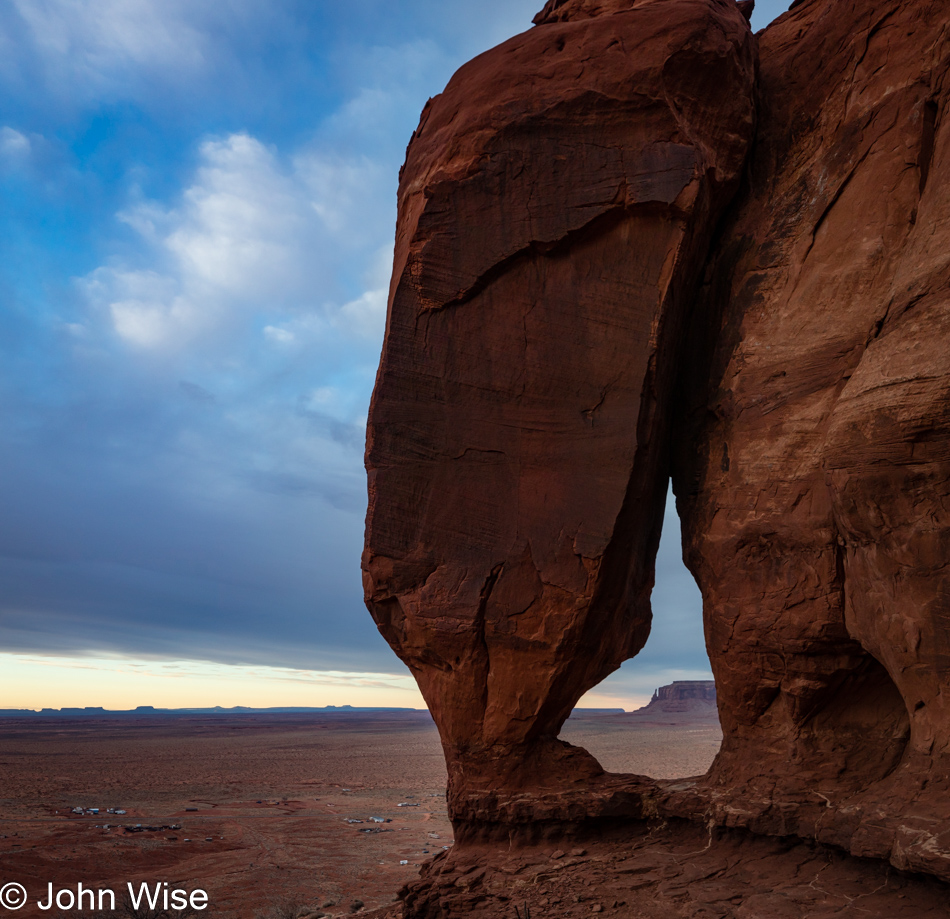
Everything hangs in the balance between potential and oblivion. The opportunity to gaze through Teardrop Arch near Gouldings Lodge can only happen because one makes oneself available to be here; this is the potential of our senses to find change. A small mound of the earth will someday give way and topple this 200 million-year-old rock perched above it, thus continuing the work of the past 25 million years in shaping Monument Valley. Right here, which was part of my right now while standing here on this late afternoon, I moved my perspective to be witness to a second carved out of a vast history where I’ll blip in and out of existence in the relative blink of an eye. We are afforded this rare opportunity to look through history while history has no interest in looking through us. Will you opt to be present to experience at least some of life with your own eyes, hands, and ears, or is the oblivion of crumbling under the force of time never to have been anywhere good enough for you?
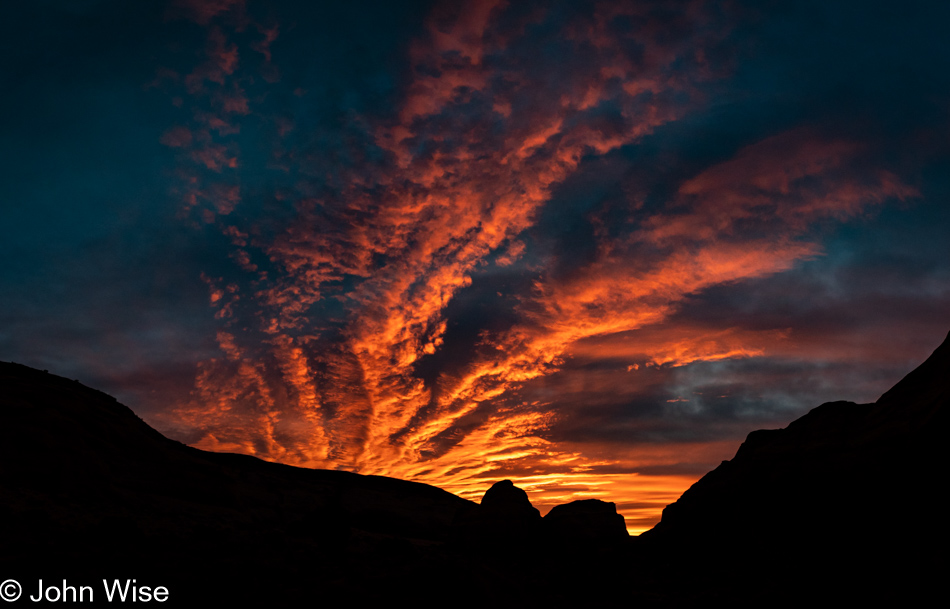
Before you know it, another day is gone, another week, month, year, and a life you held dear. That one chance you had to be available for your own life and the lives of others will have slipped by; history will forget you and those who once loved you will also accede to the demands of time, thus erasing your presence like so many clouds capturing the final rays of a setting sun letting go of the intense beauty they inspired upon an observer who happened to be at the right place at the right time to experience such a thing before our star dipped below the horizon.